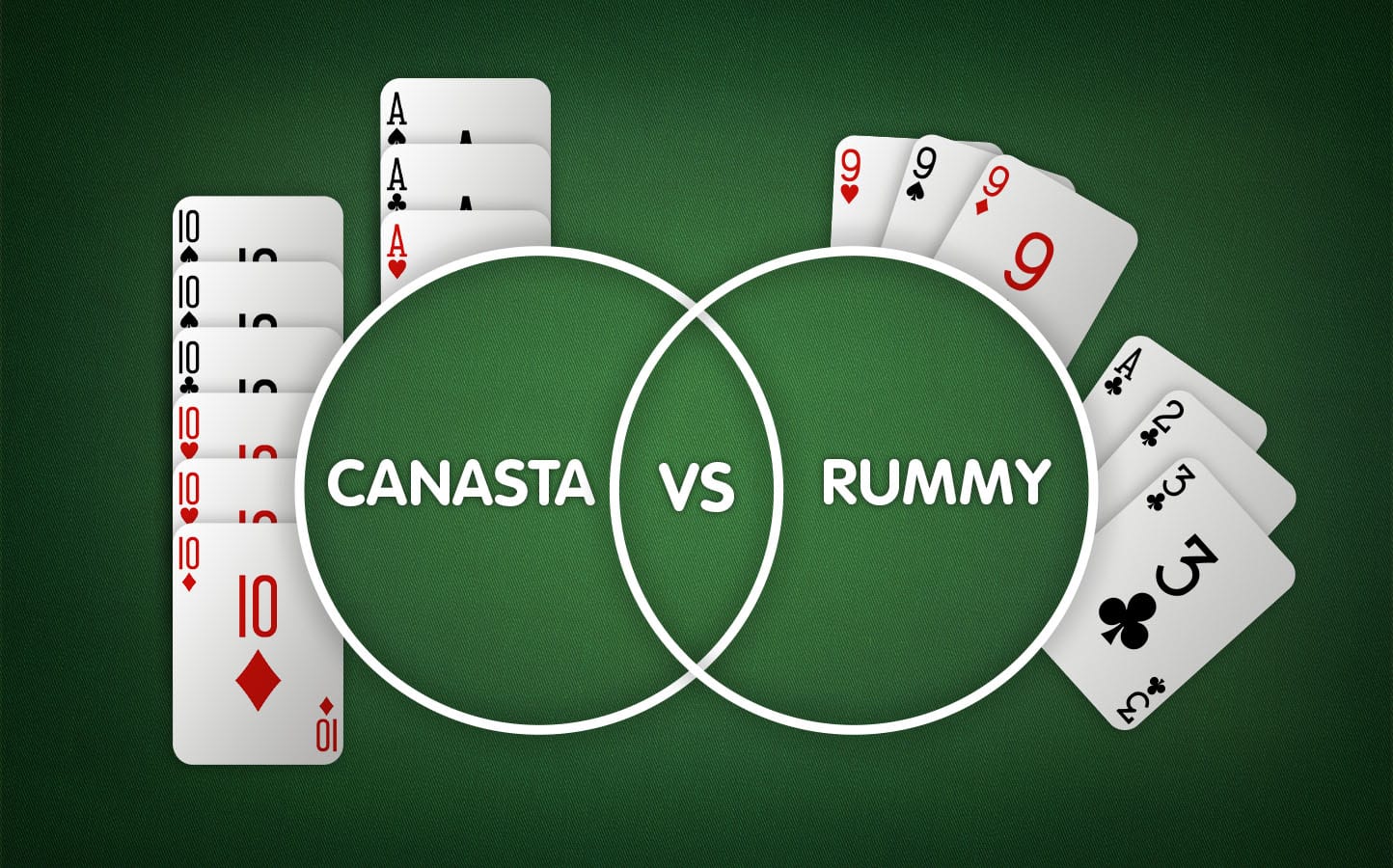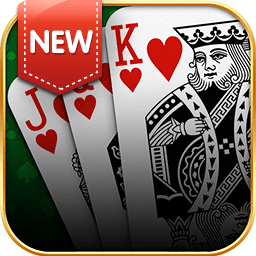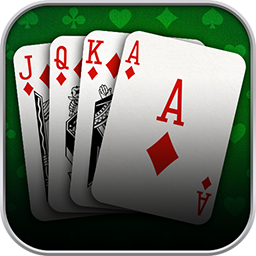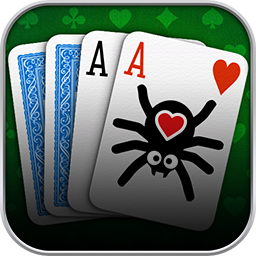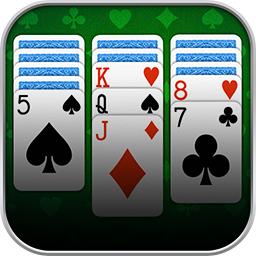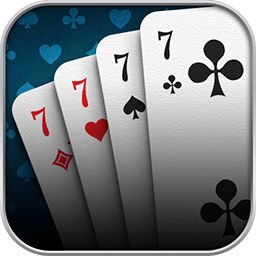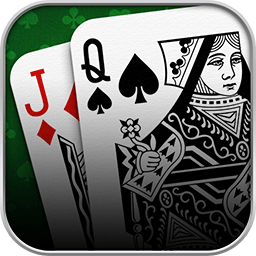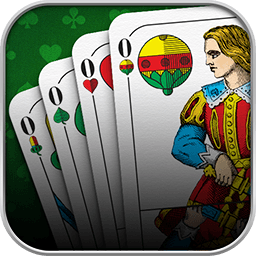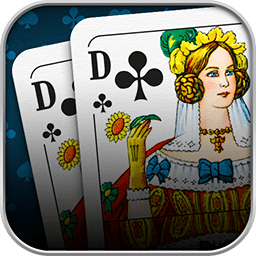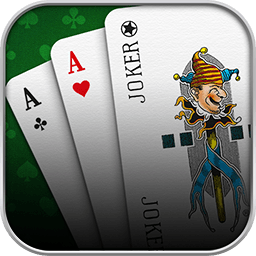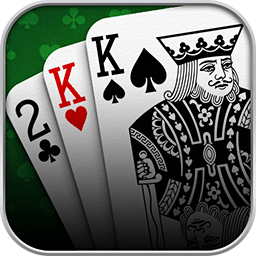Both card games, Canasta and Rummy, are considered part of the Rummy Family. That’s a big group of card games relying on combining cards into melds by following certain criteria. Often, the goal is to be the first one to empty your hand. Another popular game from this family is Gin Rummy. However, we will stick to Canasta and Rummy in this lesson.
Both of these card games are popular worldwide, with plenty of circulating variants. When comparing these games, we base our observations on our default basic rule sets at the Canasta Palace and the Rummy Palace. If that diverges from the version you are most familiar with, you can still take away the key differences between Canasta and Rummy from this lesson.
To find their similarities and differences, we will look at both games’ players, objectives, cards, gameplay, especially melding, and scoring.
Canasta and Rummy: Number of Players
Canasta is typically played with two or four players, but variants for three players and other numbers are also known. Four-player Canasta is a two-vs-two battle with members of the same team sitting at opposite sides of the table. In this lesson, we use the term your party to refer to you as a single player as well as your team in four-player mode.
Meanwhile, Rummy is always a competition for two to six single players. Rummy Palace supports either two, three, or four-player Rummy!
| Canasta | Rummy | |
|---|---|---|
| Number of Players | 2 or 4 | 2 to 4 |
What is the Objective of the Game in Canasta vs. Rummy?
The general goal in both games is to collect the most points over the course of multiple rounds. We are covering this in the scoring section further below.
In both games you finish a round, also known as going out, by emptying your hand. You do that by combining all your hand cards into valid combinations called melds.
The main difference is that in Rummy, you can only score points if you go out first, so you try to do so as quickly as possible. In Canasta, however, every card you meld awards points, and specific melds even yield bonus points. So, going out quickly is less important and it might even make sense to stall and accumulate plenty of bonus points before going out.
| Canasta | Rummy | |
| Objective each round | Meld all your hand cards, fulfill the conditions to go out, and meld or discard your last card to end the round. By doing so, you collect points for melded cards, penalty points (in four-player Canasta only), and bonus points, among others for going out. If your party’s score is higher than the other party’s, you win the round. | Meld all your hand cards and discard your last card to end and win the round as quickly as possible. This is the only way to score points. |
Finishing a round in Canasta adds a bonus to your score. But winning depends on points for melded cards, bonus points, and penalty points. We are covering this in the scoring section further below. On top, you are only allowed to finish the round if your party’s melds fulfill certain conditions.
Differences in Gameplay Between Canasta and Rummy
We won’t go into each rule set’s most hidden corners in this lesson. If you want to get to know the ins and outs of these popular card games, have a look at our Rummy Rules and Canasta Rules.
Generally, you will notice that Canasta uses more different mechanics. That’s due to Canasta being a relatively young card game, invented in the 1930s. One of its inspirations was Rummy. So if you’re asking ‘Is Canasta like Rummy?’, the answer starts with ‘Yes, and …’
Cards and Dealing
Both games use cards in the French suits Hearts, Spades, Diamonds, and Clubs, as well as a few Jokers.
After shuffling all cards and dealing cards to all players, you set the remaining cards aside face down as the draw pile in both Canasta and Rummy.
In either game, the draw pile’s top card is revealed and placed next to the draw pile as the first card of the discard pile.
The differences between Canasta and Rummy cards revolve around the exact number of cards as well as the values assigned to them. Those values play a role in melding, and by extension, also during scoring.
| Canasta | Rummy | |
| Card Deck | Two decks, each of 52 cards plus two Jokers (108 cards in total). | Two decks, each of 52 cards plus three Jokers (110 cards in total). |
| Cards Per Player | Two players: 15 Four players: 11 | 13 |
| Card Values | This depends on the bracket the cards are in, i.e., any special card, Aces, a higher-value natural card, or a lower-value natural card. Find the detailed Canasta card values in our Canasta rules. | For most cards, this depends on the displayed pip value. But for the face cards, it’s 10 points, for Aces, it can be 1 or 11, and Jokers either take on the value of the card they replace or have the value 20. Learn how Rummy card values work in the respective section of our rules page. |
Drawing and Discarding
In both games, you start your turn by drawing a card, then have time to make some moves, if applicable, before finally discarding one card to end your turn.
The Discard Pile
In both Canasta and Rummy, you need to discard one card at the end of every turn (except the final one in Canasta). Those cards go onto the discard pile.
Additionally, you are allowed to draw the discard pile’s top card instead of a face-down card at the beginning of your turn. But that has quite different conditions and implications in Canasta compared to Rummy:
| Canasta | Rummy | |
| Drawing a Card from the Discard Pile | You need to meet specific conditions to pick up a card here. Those conditions change over the course of the round, depending on the cards in or on top of the discard pile. Restrictions regarding the initial meld can apply, too. Generally, if you want to use the top card, you must meld it immediately. You never add it to your hand. Find details in the discard pile section of our Canasta Rules. | As long as there is a card here, you can draw it at the beginning of your turn if you don’t want to draw a face-down card. |
| Further Effects of Drawing from the Discard Pile | After successfully picking up the top card and placing it on the table, you gain the entire discard pile to your hand. | none |
Special Cards
Both Canasta and Rummy have cards with special uses. The difference between the two games lies in the number of special cards and their various effects.
| Canasta | Rummy | |
|---|---|---|
| Special cards | Jokers & Twos Red Threes Black Threes | Jokers |
In Rummy, the only special cards are Jokers. When melding in Rummy, you can use a Joker to replace a missing card and complete a meld. And if at any point you draw a card that fits in a Joker’s place, you can add this card and take the Joker to use it in a different position. This makes the Joker a very powerful Rummy Card!
In Canasta, more cards have a special status. Any other cards are referred to as natural cards in Canasta. You can read the details in the Canasta Cards and Values area of our Canasta Rules. But here goes the short version:
- Jokers and Twos are wild cards, which means you can use them in Canasta melds like the Jokers in Rummy melds, except you can’t swap out melded wild cards anymore if you have fitting cards for that same meld later. Additionally, the discard pile is frozen whenever it contains at least one wild card.
- Red Threes are bonus cards, which means you don’t use them for playing. Whenever you are dealt one or draw one, it’s automatically revealed and replaced. If your party played at least one meld at the round’s end, your bonus cards add bonus points to your score.
- Black Threes are block cards, which means you cannot meld them unless this is your final meld before discarding to end the round. But you can discard them and automatically block the discard pile for the next player: Whenever a black Three is the discard pile’s top card, it cannot be drawn.
How Does Melding Work in Canasta vs. Rummy?
In Rummy as well as in Canasta, you start out with plenty of cards in your hand. Over the course of the game, you arrange them into melds.
Melds are only valid if you place them open on the table. After completing your initial meld, you can also add cards to certain melds on the table during your turn.
Any cards remaining in your hand at the end of the round result in penalty points. Thus, you try to get rid of cards from your hand via melds as effectively as possible in both Canasta and Rummy.
Melds in Canasta vs. Rummy
Looking at the criteria for melds in both games brings the differences to light.
| Canasta | Rummy | |
|---|---|---|
| Minimum Number of Cards in a Meld | 3 | 3 |
| Maximum Number of Jokers (or Wild Cards) in a Meld | A maximum of three wild cards can be in a meld, while not outnumbering natural cards in that meld. | Jokers must not outnumber natural cards in a meld. |
| Melds With Cards of the Same Rank | Those are just called melds in basic Canasta. Once you reach seven or more cards in a single meld, this meld becomes a complete Canasta. Canastas without any wild cards score more points than canastas using wild cards. | Those are called sets or groups in the Rummy game. The maximum number of cards in such a meld is four, one of each suit. |
| Melds With Cards of the Same Suit | These aren’t applicable in basic Canasta, but in Canasta variants. For example, you can enable these types of melds at the Canasta Palace using our custom rule Sequences. | Those are called runs or sequences in Rummy. The maximum number of cards in such a meld is 13, one of each rank. |
| Scoring via Melds | Each melded card on your side of the table adds points to your score. Additionally, completing certain types of melds adds bonus points to your score at the round’s end. | Not applicable. Instead, scoring works via the values of the remaining hand cards of the players who didn’t go out. |
Initial meld
Canasta and Rummy both require you to take the hurdle of the initial meld each round. That means you need to place a specific minimum value on the table in melds within the same turn before playing any other melds or interacting with any melds in the playing field.
| Canasta | Rummy | |
|---|---|---|
| Minimal Value of the Initial Meld | This value depends on your current total score: | The value remains the same for every player in every round. |
Laying off Cards to Melds
As mentioned above, you can’t only meld cards, but you can also add cards to existing melds after completing your initial meld. This is true for both Canasta and Rummy. But the difference in scoring via melds (see above in Melds in Canasta vs. Rummy) affects the rules for laying off cards, too:
| Canasta | Rummy | |
|---|---|---|
| Melds you can add cards to | The canasta playing area is split into two meld sections, one for each party. You can’t add your cards to opponents’ melds. Otherwise, it wouldn’t be possible to keep track of who played which cards and, thus, deserves to score the associated points. | Everyone lays off to any meld on the table, if they can. As Rummy Scoring usually works via the remaining hand cards only, it doesn’t matter who contributed which card to what meld. |
Ending a Round in Canasta and Rummy
In both card games, the round ends once one player empties their hand. This is called going out. If that’s not you, expect to rake up some penalty points!
After this, you can play another round if you haven’t reach your agreed upon round number yet. In Canasta, your table can end earlier, in case one of the parties reaches 5,000 points before that.
| Canasta | Rummy | |
|---|---|---|
| Conditions to End a Round | Your party needs one melded canasta by the end of your final turn to go out. | none |
| How to End a Round | Discard or meld your final card. | Discard your final card. |
| Effects of Ending a Round | Scoring starts. Going out gives you bonus points during scoring. But whether your party wins depends on the overall scores from melds, bonus points, and penalty points of each party. | Scoring starts. Because scores are based on the other players’ remaining cards, you automatically win if you go out. |
| Special Mode of Ending a Round | It’s called going out concealed in Canasta. To achieve this, you must go out within one turn, and your party cannot have any melds before that. In other words, you play your initial meld and go out in a single turn. This adds 100 extra bonus points for going out (so 200 in total). | It’s called going Rummy. To accomplish this, no melds must be on the table yet. If you then end the round by playing all your cards within one turn, you are going Rummy. That doubles the opponents’ penalty points as well as the points you gain! |
As we are already touching on the topic of ending rounds, adding bonus points, and doubling score, it’s time to compare scoring in Canasta and Rummy.
Scoring and Winning the Game in Canasta vs. Rummy
In both games, you collect or lose points every round, summing them up to your total score over multiple rounds. Let’s first look at the scoring process per round:
| Canasta | Rummy | |
| Ending Party | ||
| Other Party |
With scoring per round out of the way, let’s talk about winning the entire game or table in Canasta vs. Rummy. In both games, you quite simply need to have the highest total score once the game ends. But there is a slight difference in when the overall game ends:
| Canasta | Rummy | |
| End of Table | The table can end in one of two ways: | The table ends after you finish playing a predetermined number of rounds. |
Both Canasta and Rummy have their peculiarities regarding scoring, so head over to the scoring section in the Canasta Rules and to our page about Scoring in Rummy to learn more.
At this point in the lesson, you know the difference between Canasta and Rummy. While they have some similarities, it’s clear that they are two distinct games with their individual rulesets, objectives, characteristics, and perks. Do you have a favorite yet?
For a complete overview of either game’s rules, have a look at our pages on the rules of Canasta or the Rummy Rules.
